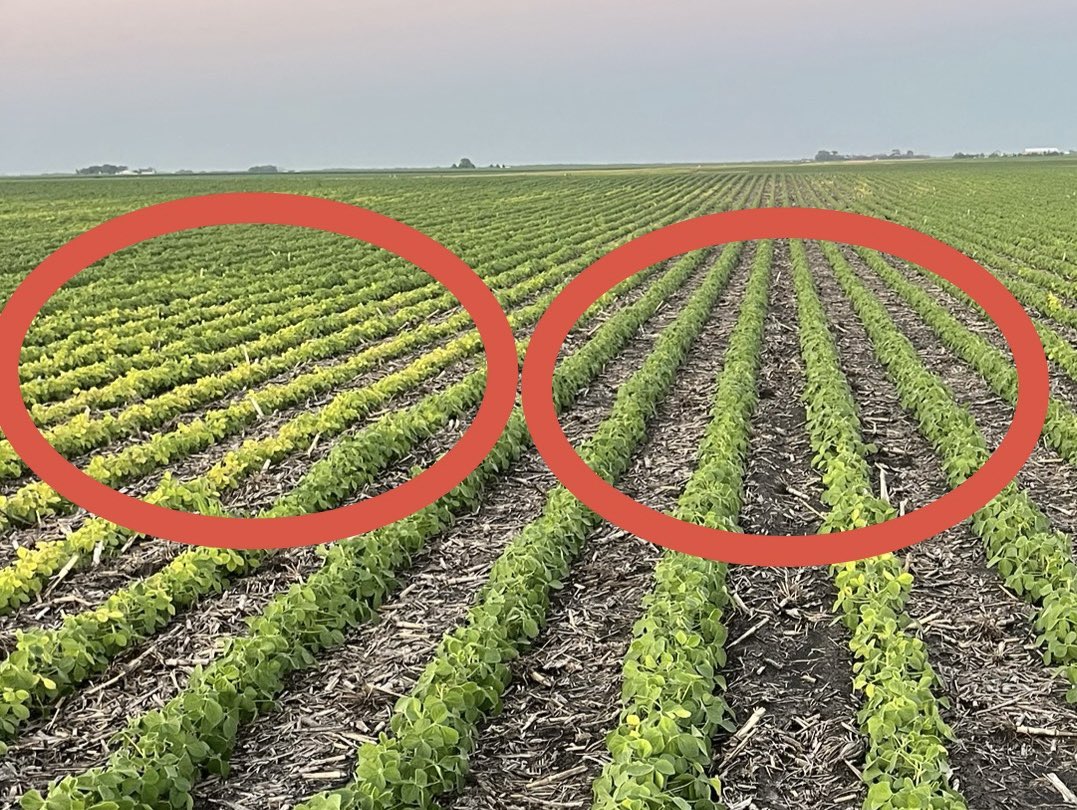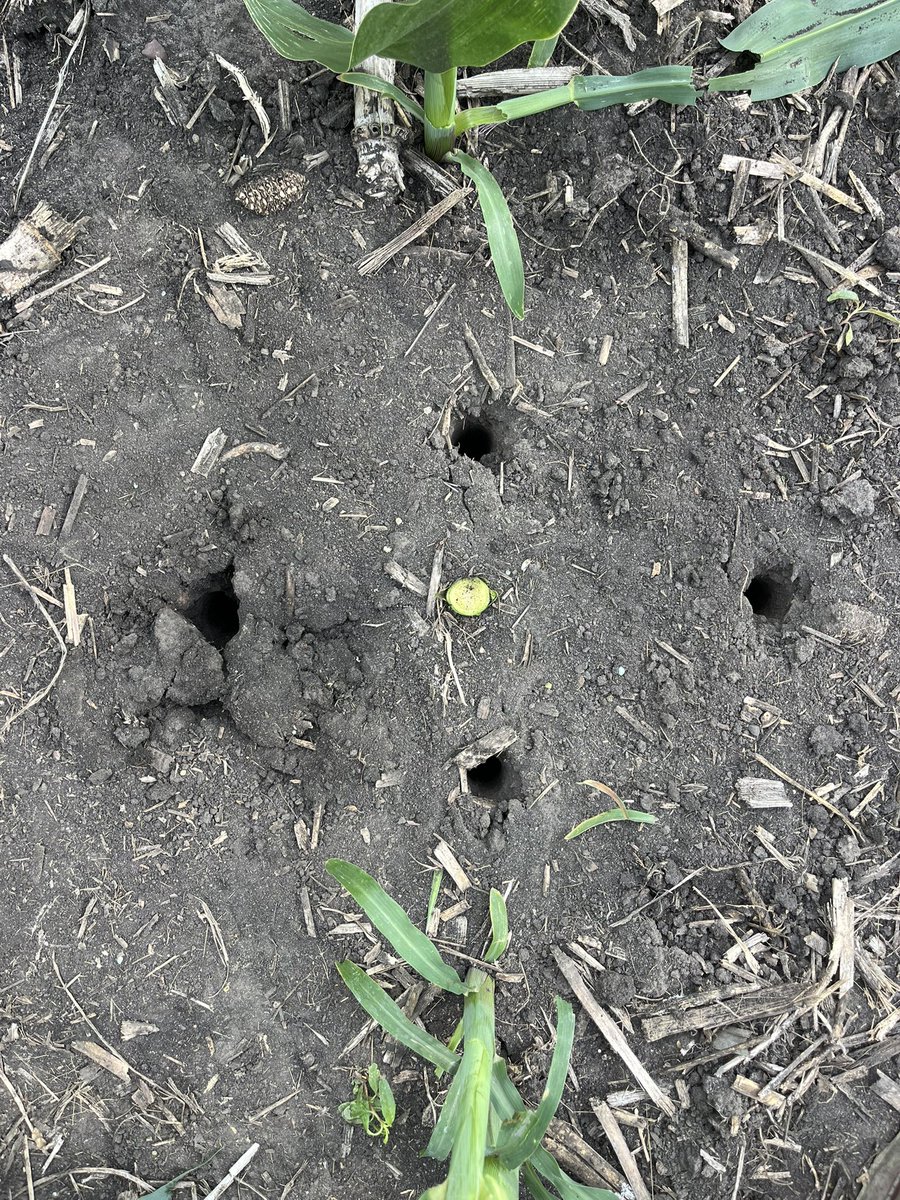
Mason Claude
@MasonClaude5
IA/MN Agronomist @BW_Fusion and Farmer
🔥Hot take I’d rather not pollinate a handful of kernels per ear at R1 than to abort pollinated ears at R2-R3 and waste the energy already invested into that kernel. Either way it’s going to impact yield but the first may be a lighter blow
All the experts on here what’s your opinion how much does that pollination take off the yield?
"You want to fix your soil? Don’t chase potassium. Fix your calcium, fix your carbon, and your roots will find what they need.” - Dr. S.A. Khan, University of Illinois Episode 43: The Potassium Paradox: youtu.be/BZxdtZ93v_o
🔥 Hot Take: Most farmers are over-liming In calcareous soils, excess lime ➡️ raises pH even higher And what happens in high pH? Fe³⁺ locks up. No availability = IDC. Stop chasing pH > 6.0 in every zone. Know when to back off the lime Use pH, buffer pH, and base sat H
Let’s talk management strategies Start with your corn N program Excess fall N in the soil fuels IDC next spring ✅ Split N applications ✅ Target a NUE of 0.6–0.8 ✅ Use Agronomy 365’s SET test to measure mineralization potential Right N rate = less spring nitrate = less IDC
The top 3 most important plant elements are Carbon, Hydrogen, Oxygen!
Farming on a tight budget. How much N is really needed? Corn on Corn, No manure spread etc. Eliminate plant stress the best you can, supplement micros when needed. And pay close attention & be prepared to add more, the remaining needed nutrients will be provided with Foliar app!
Let’s talk management strategies Start with your corn N program Excess fall N in the soil fuels IDC next spring ✅ Split N applications ✅ Target a NUE of 0.6–0.8 ✅ Use Agronomy 365’s SET test to measure mineralization potential Right N rate = less spring nitrate = less IDC
So what’s the root cause of IDC? 2024 showed us something weird, IDC didn’t pop early—it snuck in late. So what changed? Let’s break it down: this isn’t just about iron. It’s about pH, nitrate, oxygen, and a failure in the plant’s nitrogen-to-protein machinery. 👇 #Soybeans25
Think beyond Fe, ferredoxin needs Fe: central cofactor S: part of its iron-sulfur cluster Mo: nitrate reductase Mn: chloroplast activity Cysteine: key amino acid Without Mo the plant can’t efficiently convert nitrate → ammonium so nitrate builds up and IDC worsens #AgX
Nitrate has to be converted to ammonium before a plant can build amino acids That conversion requires ferredoxin, an iron-based protein No ferredoxin = nitrate bottleneck So the plant keeps taking up N… but can’t use it Instead, nitrate accumulates—and chlorosis sets in #Agx
Nitrate has to be converted to ammonium before a plant can build amino acids That conversion requires ferredoxin, an iron-based protein No ferredoxin = nitrate bottleneck So the plant keeps taking up N… but can’t use it Instead, nitrate accumulates—and chlorosis sets in #Agx
Let’s go back to the tissue tests: 🟡 IDC area -3,167 ppm nitrate -5.5%N 🟢 Non-IDC area -540 ppm nitrate -4.29%N That’s a 486% increase in nitrate in the IDC zone So what’s going on? The issue isn’t uptake It’s assimilation #AgTwitter #IDC #Soybeans25
Let’s go back to the tissue tests: 🟡 IDC area -3,167 ppm nitrate -5.5%N 🟢 Non-IDC area -540 ppm nitrate -4.29%N That’s a 486% increase in nitrate in the IDC zone So what’s going on? The issue isn’t uptake It’s assimilation #AgTwitter #IDC #Soybeans25
So why does the IDC area have more ppm Fe while still showing chlorosis? Under high pH, DTPA measures mainly ferric Fe—unavailable Soybeans need is Fe²⁺—available So yes—Fe is there. But it’s not working, it needs to be reduced #IDC #SoilChemistry #Soybeans25 #AgTwitter
Agronomist from Iowa, Mason Claude does an excellent job explaining what he’s looking at when checking corn. He splits the stalks to better understand the stress level of the plant.
So why does the IDC area have more ppm Fe while still showing chlorosis? Under high pH, DTPA measures mainly ferric Fe—unavailable Soybeans need is Fe²⁺—available So yes—Fe is there. But it’s not working, it needs to be reduced #IDC #SoilChemistry #Soybeans25 #AgTwitter
Want to go deeper? Guess which area had more Fe in the soil? 🟢 Non-IDC: 10 ppm Fe 🟡 IDC-affected: 44 ppm Fe More Fe in the soil & tissue So the question isn’t how much iron is there …it’s can the plant actually use it? #AgTwitter #SoilScience
This is why I test everything with @Agronomy365 📍Same field, 10 feet apart Y-drop with BW BioCast Max vs. untreated check Result? 54% higher CO2 respiration → 17 more lbs of N in the plant-available form Biology isn’t hype—it’s horsepower. #AgTwitter #OnFarmResearch
Your soil’s biology holds the key to in-season N release—but you have to measure it. It helps predict how much organic N might mineralize, giving real data to fine-tune N rates 🧪 Biology isn’t a side metric—it’s the missing link. #AgTwitter #NitrogenManagement #SoilBiology
Want to go deeper? Guess which area had more Fe in the soil? 🟢 Non-IDC: 10 ppm Fe 🟡 IDC-affected: 44 ppm Fe More Fe in the soil & tissue So the question isn’t how much iron is there …it’s can the plant actually use it? #AgTwitter #SoilScience
🚨Same field. Same soybean variety. Two drastically different outcomes. Left: IDC symptoms Right: wheel tracks The IDC area has 623 ppm Fe in the tissue. The “healthy” area? Just 326 ppm Fe. 🤯 So… is the plant really low on iron when we see IDC? 📸👇 #AgTwitter #Soybeans25
Healthy plants create healthy soils!
Josh Messer, does an excellent job explaining the basic principles of an efficient crop. Protect the plant = better sunlight harvest = better and more abundant sugar production = better soil exudation = better microbial life = better nutrient efficiency.
🚨Same field. Same soybean variety. Two drastically different outcomes. Left: IDC symptoms Right: wheel tracks The IDC area has 623 ppm Fe in the tissue. The “healthy” area? Just 326 ppm Fe. 🤯 So… is the plant really low on iron when we see IDC? 📸👇 #AgTwitter #Soybeans25

There is nothing more fun than a trial that shows nothing Why? Because everything always kinda works sometimes The key is knowing when and why—and that takes data, context, and an honest look at what’s limiting yield in the first place. That’s the real work #OnFarmResearch
You can’t manage what you don’t measure In season testing is necessary for validation and fine tuning that can render big $$
